EARLY GATTERs OF THE AMERICAN EAST COAST
(Part One)
Settlers
in Jamestown and Mulbury Island
and the founding of Gaithersburg
The first Gatters to appear in the New World, were English settlers that establieshed themselves at Jamestown and Mulbury Island Virginia. In 1620 John Gatter arrived as a young man of just over 20 years of age on the ship "George" in Virginia. He was first living at "James Cittie" and later moved to Mulbury Island (1624 census).
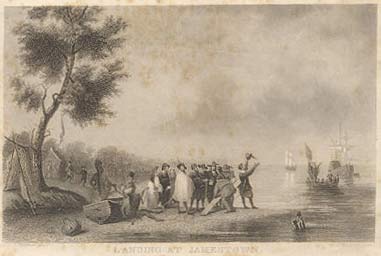 |
|
Landing at Jamestown, Virginia, around 1600 |
It might have been due to the chronic lack of "civilized" women in the New World that he again returned to England where he married a certain Joan. In 1635 the family travels back to Virginia. The ship list of the "Assurance", dated 14 July 1635, reads: "Jo: Gater aged 36, Joan Gater age 23, and Jo: Gater age 15.
Jamestown was founded on May 14, 1607, by a small group led by Captain Christopher Newport, who was hired by the London Virginia Company to transport colonists. It was to become the first permanent English settlement in America. It is located in present-day James City County, on an island in the James River, southeast of Richmond, part of the 3816-hectare (9430-acre) Colonial National Historical Park.
Of 6,000 settlers the London based Virginia Company sent to Jamestown between 1607 and 1625, 4,800 died. The colonists were poorly chosen - with far too many gentlemen, servants and specialized artisans and far too few farmers.
The colony was poorly led, its officers engaged more in power struggles than in making sure that Jamestown had enough food, a healthy source of water, and well-maintained defenses. The settlers worked hard - at enterprises that met with only mixed success. Virginia Company investors wanted colonists to extract New World riches. Instead of spending time growing crops, settlers were instructed to search for gold and other commodities and turn Virginia's raw materials into profitable industries while bartering with Indians for food. Recent excavations found great quantities of scraps of copper - leftovers from pieces cut and shaped into ornamentsprized by Indians. Copper was supposed to buy the colonists' food, but two things happened that the Virginia Company did not foresee. First, sailors on the ships that brought and supplied the settlers made calendestine black-market deals with the Indians that glutted the copper market and devalued the metal. Then drought took hold of Tidewater Virginia. Recent studies of tree rings have revealed that 1606-1612 was Jamestown's driest seven year period in 770 years. Indian tribes that had eagerly provided corn stopped. No amount of copper would change their minds. The English response - raiding Indian villages to seize food - provoked attacks by that left James Fort besieged. In 1609-1610 the crisis reached a critical time known as the "Starvation Time". Archeological excavations unerthed remains of this desperate winter. Within the fort lay butchered bones of animals the settlers would only have eaten in extreme hunger - cats, dogs, horses, rats, snakes, even poisonous ones. Utterly spent and without food, the remaining colonists in 1610 boarded ships to abandon Jamestown. As they began to sail away, a supply ship arrived. The settlers returned to Jamestown and the colony endured to become Virginia's first capital. To recruit more colonists, raise capital, and control the sale of the new cash crop, tobacco, the Virginia Company started issuing parcels of land to settlers and to others who bought shares. As a further incentive to colonists, the company created the Virginia General Assembly in 1619. It was the first represantative body, the origin of the American form of government. Settlers could own land and vote - private enterprise and fredom - the seeds that would grow into the United States. For Indians it would mean near extinction. For Africans shipped to tobacco plantations it would mean slavery. But for colonists willing to risk death on a frontier, it would mean unheard of opportunity.
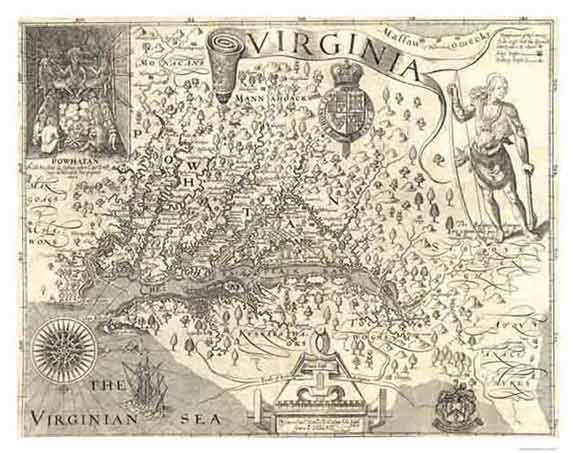 |
|
Map of the Virginia Colony in 1624
|
|
Passenger
List Extract of the "George" in 1620 - from the Port of
London to Virginia
|
|
Muster of the inhabitants of Virginia settlements, January-February, 1624/5 Settlers living at "Mulbury Island" in Virginia, January 25, 1624/5 Name Age Arrival Aldon, Richard
. . . . . . . . 19 Arrived on the George in 1620 |
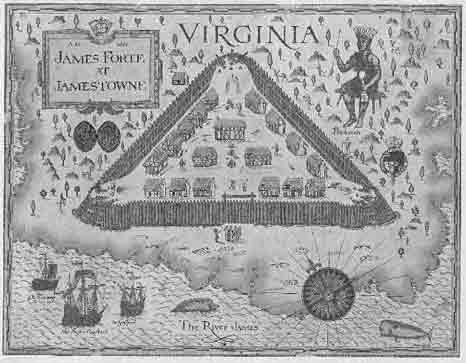 |
|
James Fort at Jamestown in around
1610
|
On 21 September 1636 John Gatter was granted three tracts of land, two
of 300 acres and one of 200 acres in Elizabeth City County for transportation
of himself, wife Joane Gater and 14 other persons: Thos. Hals, Christo.
Burston, Edward Bosaker, Thomas Rouse, William Plesbury, Richard Tysley,
Thomas Merrideth, Francis Merrideth, Thomas Meades, Robert ---, Henry
Geiles, and other names not given.
On 26 July 1638 John Gater was granted 800 acres in the Lower County of New Norfolk. The land description was the same as the previous grant, and was for the transportation of John Gater, Jane Gater, Tho. Hale, Christ. Barston, Edward Besaker, Tho. Rouse, Wm. Plesbery, Rich. Tisley, Thomas Merrideth, Fr. Merrideth, Tho. Meades, Robert ---, Wm. Goldsmith, Wm. Rice, Edward Windett, and Wm. Johnson.
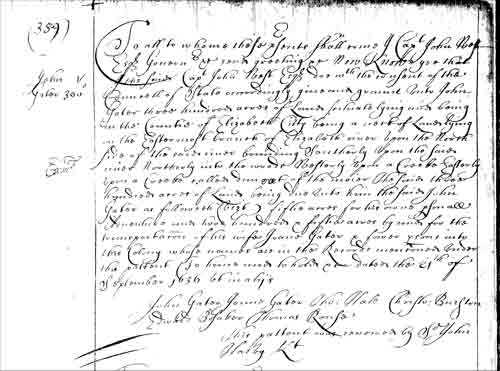 |
|
Land Patent for John Gator I. of 1636 |
 |
At a court on 16 Jan. 1653 (1654) a deed from John Godfrey of the County of Lower Norfolk to Thomas Dadford for 800 acres was ordered to be recorded. The deed was dated 16 Jan. 1653 (1654) and was stated to be 800 acres originally granted to John Gather by patent on 26 July 1638. The original grant was recorded in Nansemond County on 12 July 1649. "John Gater aforesaid by & with consent of Mary Gater his wife" had assigned the land to John Godfrey on 12 July 1649 for other considerations.
Since John Gater's grant included land for transportation of his wife Joan, and was assigned by the "aforesaid" John Gater and wife Mary, this shows this is the same man with two wives. From this deed it would appear Newman was incorrect that Mary was the wife of John Gater II, and that George Riggs Gaither was correct that there were only two early generations of John Gaters.(18) There being only two early generations of John Gater's, this would make it unlikely the John age 15 on the "Assurance" was a son of the elder John.
In Lower Norfolk County, Virginia on 16 February 1645 (1646) John Geather was granted administration on the estate of Henry Walters. On 10 June 1646 at James Citty, William Berkeley signed an order that whereas Waters died intestate, administration was granted John Geather "as Brother in law to the said deceased." At court on 15 June 1647 the accounts produced by John Geather administrator of Henry Waters were examined. At the same court the inventory of Henry Waters taken 10 Dec. 1646 was exhibited by John Geather and appraised by Peter Porter, George Horner, John Browne, and Thomas Tooker. Among John Geather's charges were "for 2 years dyett and washing" indicating Henry Waters must have lived with him before his death. In November 1642 Henry Waters had demanded 100 acres for the transportation of himself and (faded) Hally.
Some people have assumed that Waters was the maiden name of John Gater's wife Mary, but there is nothing to indicate this. If they were brother's-in-law in the modern sense, then either John Gater's wife (Joan or Mary) was a Waters, Henry Water's wife was a Gater, or their wives were sisters, surname unknown. The question is if Henry Waters wife was not a Gater, then which of John Gater's wives, Joan or Mary, was sister to either Henry Waters or his wife? Keeping in mind usage of the term brother-in-law in that time, another possibility is that John Gater and Henry Waters may have been step-brothers or half brothers.
John Gatter's son John Gather II. married Mary, and was among the migration from Virginia to Maryland in 1649/1650. His widow Mary Geather was granted letters of administration on his estate 20 November 1652 as the widow of John Geather of Anne Arundel County. John Gaither III, the son of John II and Mary, was born about 1646 and on 8 October 1662 requested renewal of a land warrant for 460 acres. It is assumed that John III was under the care of Thomas Meares for a time, since Meares bequeathed him a legacy in his will. He married Ruth, and they had 8 children born in All Hallow's Parish, Anne Arundel Co., MD:
| 1. |
John GAITHER b. 15 Jan. 1677/8; m.1. Jane BUCK 21 Aug. 1701; m.2. Elizabeth (DUVALL) WARFIELD 20 Aug. 1719; died between 4 May and 20 June 1739 Anne Arundel Co., MD | |
| 2. | Ruth GAITHER b. 8 Sep. 1679; m.1. John WARFIELD 16 Feb. 1696/7; m.2. Daniel CARTER 17 June 1718; living 1728 | |
| 3. | Benjamin GAITHER b. 20 Feb. 1681/2; m. Sarah BURGESS 8 Sep. 1709; d. between 26 Mar. and 31 Aug. 1741 Anne Arundel Co., MD | |
| 4. | Rachel GAITHER b. 19 Apr. 1687; m. Samuel WHITE 18 Apr. 1706; living 1742 | |
| 5. |
Edward GAITHER b. 28 Sep. 1689; m.1. Mary DUVALL 21 Feb. 1709/10; m.2. Rachel; died between 2 Jan. and 10 Apr. 1741 Anne Arundel Co, MD | |
| 6. | Mary GAITHER b. 13 Apr. 1692; m. Joseph WHITE 9 Feb. 1709/10 | |
| 7. | Rebecca GAITHER b. 24 May 1695; m. Richard STIMSON; living 1742 | |
| 8. | Susannah GAITHER b. 22 July 1697 |
The descendants of the pioneer John Gatter number several thousand today.
The family name has however changed over time from Gatter to Gather and
Gaither. There are no known descendants that would still carry the
name Gatter today.
A number of descendants from this line have founded the
Society of John Gaither Descendants. Check the following
3 web pages for this line:
http://home.inreach.com/calcoca/family.htm
http://familytreemaker.genealogy.com/users/k/i/b/Samuel-G-Kibler/?Welcome=1058095168
http://www.rootsweb.com/~vamip/vamip/gaither.htm
Gaithersburg
After one of the descendants of this line, the pioneer Benjamin Gaither, Gaithersburg in Montgomery County (Maryland) was named. Gaithersburg was in the 1760s a small village of log houses built on the grounds of what is now Summit Hall Farm Park. Called, "Logtown" or "Germansburgh," these settlements were the first of what would be modern Gaithersburg. Benjamin Gaither first built his home and blacksmith's shop, near the ancient Forest Oak tree, in 1802. The Forest Oak, a very large oak tree, grew at the site for nearly 300 years before it was felled during a powerful thunderstorm in the summer of 1997.
By the early-1800s, the area around the post station was known as "Forest Oak," named after the many large oak trees that shaded the town's streets. The railroad came to Forest Oak in 1873and the railway station used the name "Gaithersburg". It took almost 100 years for area leaders to agree in 1878 to name the entire town "Gaithersburg".
The building of the railroad spurred a boom in business
and residential growth around Summit and Diamond avenues. Farmers took
advantage of the railroad to ship their goods to market before they spoiled,
and the region prospered. The city incorporated shortly after in 1878,
and Gaithersburg, as the city was now called, became a popular summer
destination for vacationing city dwellers from Washington, D.C.
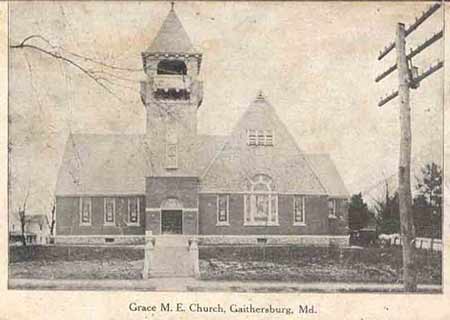 |
Gaither-Gatter DNA-Testing
In our Gatter DNA study, also a descendant of this family took part. With its to date small number of participants, no link was found to exist between the Gaither and Gatter families and they appear to be independent surname branches. However, to identify the haplotype of this family, testing of more than one descendant would be needed to exclude cases of unknown adoption or extramarital events, etc.
Click here for Part Two
Copyright:
Gatter Archive 2000-2008
Any distribution and use of material displayed on the Gatter History Archive
Web Page
other than for personal purposes will be prosecuted
Contact